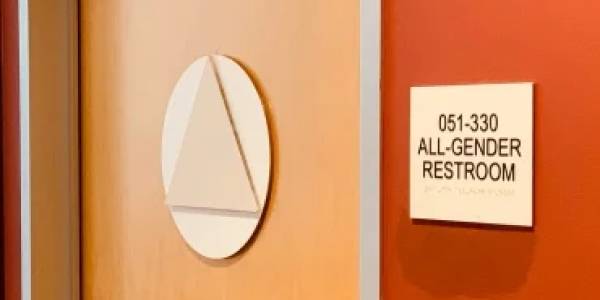By Sarah Holder, EDI Program Manager & Kayla Ninh, LCLS RIX Instrument Manager
Hello, SLAC Fam! My name is Kayla Ninh, and my pronouns are she/they. We recognize that for many reasons, stating your pronouns when you introduce yourself can be awkward or difficult, but here we will shed some non-radioactive light on the situation! Whether you are questioning your own identity or you genuinely had no clue one’s pronouns could change, the most important part to learn from this article is to recognize and respect people as individuals.
Announcing your pronouns is quickly becoming a societal norm, and as a follow up to Pride Month, this is the perfect chance to encourage all folks in the SLAC community to create an environment where everyone feels comfortable to be themselves.
- Kayla
********************
FAQ Highlights
What are my pronoun options?
- She/her/hers
- He/him/his
- They/them/theirs
- Ze/hir/hir (e.g. Tyler ate hir food because ze was hungry.) Ze is pronounced like “zee” and can also be spelled zie or xe, replacing she/he/they. Hir is pronounced like “here” and replaces her/hers/him/his/they/theirs.
- Name/name/name (e.g. Ash ate Ash’s food because Ash was hungry.) Some people prefer not to use pronouns at all, using their name as a pronoun instead.
See this handy chart from the Human Rights Campaign for examples.
Note: Some people go by more than one set of pronouns.
Nonexhaustive Glossary of Terms
- Gender binary: a concept that assumes that there are only two “biologically determined” genders, man and woman, and that all people occupy one of those genders.
- Gender spectrum/circle: a concept that assumes that there are many genders that exist along a spectrum between man and woman, and that gender is not “biologically determined;” some people refer to this instead as a circle, which removes the assumption that the binary man/woman genders are at the end points but instead are part of a continuum.
- Misgender: to refer to someone using a pronoun, former name or other identifiers that do not correctly reflect the gender(s) with which they identify.
- Cisgender: a person whose gender aligns with their assigned birth sex and assumed gender; “Kelly is a cisgender woman. Her pronouns are she/her.”
- Transgender/Trans*: a person whose gender does not match their assigned birth sex- this is a broad category, with a lot of intergroup diversity. Some trans* people identify as one of the binary genders, man or woman, and some identify as a different or no gender label; trans* people may use binary or nonbinary pronouns, or both/all, and may or may not alter their hormones and physical appearance to match their gender identity.
- Nonbinary: both a gender label and an adjective used to describe a person whose gender does not align perfectly with one of the binary genders, man/woman, and instead falls elsewhere on the spectrum or circle.
- Gender non-conforming: a broad umbrella term that refers to people whose gender expression and behavior do not conform to traditional expectations of their presumed gender, (e.g., cisgender men who wear high heels and other clothing typically assigned to women).
Why do pronouns matter?
In English and other languages, pronouns are tied to binary genders and are a common form of misgendering for trans* and nonbinary people. Stating your pronouns is telling another person(s) how you identify. Asking for and using someone’s correct pronouns is both a show of respect and a signal that you see that person for who they are.
For allies, introducing yourself including your pronouns — and including your pronouns in your email signature and Zoom name — helps to destigmatize pronoun sharing and challenges assumptions that pronouns are always a reflection of gender expression.
It seems pretty nerve-wracking to try since it is so important. What if I mess up?!
Oh, there is no IF... you WILL mess up at some point! We all still mess up! Even when we have been practicing for years, mistakes can happen anytime. We are programmed to think and see things a certain way, and unlearning that is not an easy process. The best thing you can do if you use the wrong pronoun is to simply correct it right away, such as by saying, “Sorry, I meant [insert correct pronoun],” or, if someone corrects you, saying, “Thank you, I meant [insert correct pronoun.” If you realize your mistake after the fact, you can offer a simple apology in private. Belaboring the apology or talking about how hard you’re trying will center the situation around yourself and can make the other person feel obliged to put you at ease.
We cannot give you a standard operating procedure for this because every human is on their own journey that affects how they feel and grow. The best thing we can recommend is not to dwell on the mistake, but to focus on doing (not just saying!) better. It takes bravery for someone to come out and live their authentic life. The best we can do as colleagues, coworkers and friends is to respect and model that bravery by using the correct pronouns.
What about the whole men/women bathroom thing?
A substantial proportion of single-stall bathrooms at SLAC have been swapped from their traditional men/women designations to be gender neutral, meaning that anyone can use these single-occupancy stalls. This design switch benefits many people, including parents with young children, anyone looking to change outfits, or anyone who needs a moment of privacy. For trans*, nonbinary and gender nonconforming people, bathrooms can be a huge source of anxiety and fear. Just needing to use the restroom can lead to uncomfortable looks, questions, and confrontations about their gender or gender expression. Gender neutral restrooms remove the worry and reaffirm safety and sense of belonging.
How can I support my trans*, nonbinary and gender non-conforming colleagues at SLAC?
Great question! Some simple things that pack a punch are adding your pronouns onto your email signature/Zoom name [e.g. Ze Doe (they/them)], introducing yourself with your pronouns, and asking your colleagues (whom you may have known for years!) what their pronouns are. Who knows, you may be surprised! A note that if you feel awkward saying your pronouns or using non-binary pronouns: Don’t worry as most new habits feel strange at first. We suggest you try practicing it out loud and/or with a trusted friend. If you’re a manager, you can lead the way for your entire team. Try using gender-neutral pronouns for people you haven’t met yet or don’t know, like candidates for an open position or potential external collaborators, when referring to them in meetings.
Additionally, one of the best ways you can show support is to keep learning! Sharing this article with your colleagues is an easy way to help spread awareness and show your support.
I have more questions! What should I do?
Oh golly, don’t we all?! We are so glad you have more questions. Below are some resources we have compiled. We especially encourage you to read these as a follow up to Pride Month, which commemorates and celebrates the LGBTQIA+ community and the Stonewall Uprising.
As this article comes to a close, we want to emphasize that although grammar rules are important, nothing is as important as people. Whether you are questioning, confident, and/or first learning about gender identity and pronouns, let’s all remember that we are still learning and will inevitably make mistakes. We want to make SLAC the best and most welcoming environment it can be, and we’re happy you’re along for the ride.
RESOURCES



